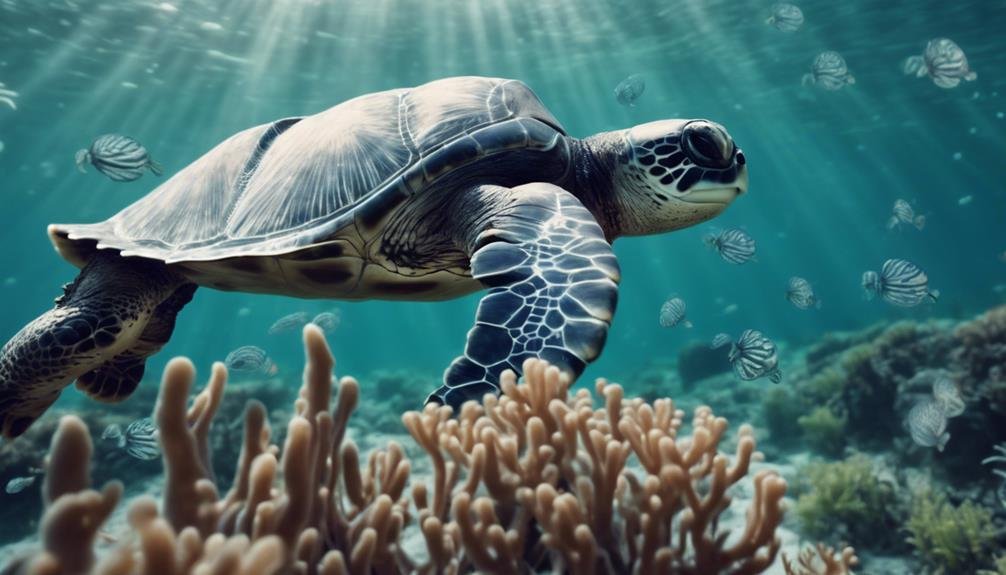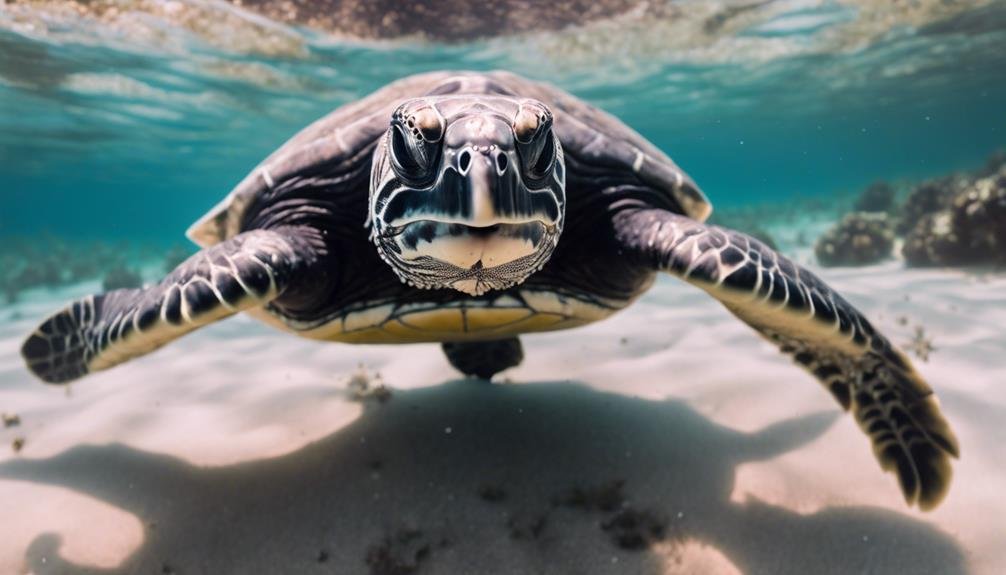You’ve likely heard of leatherback sea turtles, the largest of all living turtles, renowned for their extensive migratory patterns across the world’s oceans. From the tropical beaches where they nest to the jellyfish-rich waters they frequent for feeding, these majestic creatures cover vast distances. However, what you might not know are the specific locations that serve as vital safe havens and feeding grounds for their survival. As they navigate through threats like climate change and marine pollution, identifying these areas becomes essential. Let’s explore the key habitats that support the life cycle of these fascinating marine giants and why their conservation is crucial for our ecosystems.
Key Takeaways
- Leatherback sea turtles inhabit tropical to temperate zones globally, including the coasts of the United States and islands like Puerto Rico.
- They rely on specific tropical beaches for nesting, which are crucial for their survival and reproduction.
- Leatherbacks forage in jellyfish-rich waters of the Pacific, Atlantic, and Indian Oceans, playing a key role in marine ecosystems.
- Their feeding grounds include pelagic waters far from shore, where they travel long distances to find food.
- Conservation efforts focus on protecting nesting beaches and feeding sites from threats like pollution and habitat destruction.
Global Distribution
Leatherback sea turtles roam the oceans far and wide, from tropical to temperate zones, including both coasts of the United States and distant waters of Puerto Rico, the Virgin Islands, and Hawaii. These majestic creatures have a global distribution, making them one of the most widely traveled marine animals. Whether it’s the cold waters off the East Coast or the warmer seas to the West, Leatherbacks are there, traversing vast distances in search of jellyfish, their primary prey.
You might wonder how these turtles manage to thrive in such diverse environments. Their unique physiology allows them to regulate their body temperature, enabling them to inhabit a range of sea temperatures. This adaptability is key to their survival, as it allows them to explore the open ocean and coastal waters across the globe.
Their presence in both tropical and temperate seas underscores the remarkable nature of their global distribution. From the United States to the far reaches of the East and West, Leatherback sea turtles embody the essence of marine wanderers, calling attention to the interconnectedness of our world’s oceans.
Key Habitats Identified
While these turtles roam vast oceans, they depend on specific tropical beaches for nesting, where females lay their eggs to guarantee the next generation. Nesting beaches are pivotal for the survival of the leatherback population.
These areas, scattered across the globe, from the coasts of the United States to the shores of Puerto Rico and the Virgin Islands, serve as critical habitats where leatherbacks can safely lay their eggs. The Pacific leatherback turtle, in particular, showcases remarkable migration patterns, traveling thousands of miles between nesting beaches and feeding areas, highlighting their adaptability yet underscoring their vulnerability.
Conservation efforts are essential in protecting these key habitats from threats such as climate change, which alters beach environments and nesting conditions, and marine pollution, which endangers leatherbacks at sea. Protecting nesting beaches and the surrounding waters is crucial to ensure that leatherbacks have a safe haven to reproduce and forage.
These efforts not only help to sustain the leatherback population but also contribute to the overall health of marine ecosystems, illustrating the interconnected nature of oceanic life.
Feeding Grounds Explored


As you explore the vast oceans, you’ll find leatherback sea turtles foraging in a variety of global habitats, from the balmy tropical waters to the cooler temperate zones. Their diet isn’t just about jellyfish; it’s about the diversity of prey available in these different locales.
However, many of these critical feeding sites are under threat, impacting not only the turtles’ survival but also the balance of marine ecosystems they help maintain.
Global Foraging Habitats
Exploring the vast oceans, leatherback sea turtles forage in the Pacific, Atlantic, and Indian Oceans, seeking out jellyfish-rich waters to sustain themselves. These majestic creatures venture across global habitats to locate their key feeding grounds, demonstrating an incredible capacity for long-distance migration to reach areas abundant in their preferred prey.
Their journeys take them through pelagic waters, the open ocean territories far from shore, where jellyfish populations thrive, providing the necessary nourishment for these turtles. By feasting on jellyfish, leatherbacks not only find their sustenance in these productive feeding areas but also play a critical role in maintaining marine ecosystems. Their presence helps control jellyfish populations, ensuring the health and balance of oceanic life in their chosen foraging habitats.
Diet Diversity
Leatherback sea turtles boast a varied diet, including jellyfish, seaweed, fish, and crustaceans, as they roam tropical and temperate waters globally in search of food. Their foraging habits play an essential role in maintaining the balance of marine ecosystems, especially by controlling jellyfish populations. These ancient mariners embody a pelagic lifestyle, mainly dwelling in the open ocean but also venturing into coastal waters to feed.
Here’s what stands out about their diet diversity:
- Jellyfish: A favorite, helping control their populations.
- Seaweed & Crustaceans: Adds variety, found in both open and coastal waters.
- Fish: Occasionally part of their diet, showcasing their adaptability.
Their extensive foraging grounds, from the East and West coasts of the United States to Puerto Rico and beyond, underscore the leatherback’s critical role in marine ecosystems.
Threatened Feeding Sites
Essential for their survival, leatherback sea turtles depend on feeding grounds that are currently facing significant threats. You’ll find leatherbacks frequenting the West Coast of the United States, where they feast on abundant jellyfish populations.
However, these vital feeding sites are under siege from habitat destruction, pollution, and adverse impacts from fishing activities. It’s not just about the immediate danger to the leatherbacks; the long-term viability of these majestic creatures hinges on the health of their feeding grounds.
Conservation efforts are tirelessly working to protect these areas, recognizing that safeguarding the leatherbacks’ feeding sites is fundamental for their survival. Ensuring these threatened feeding sites remain viable is a cornerstone of leatherback conservation, aiming to secure a future where leatherbacks can thrive without the looming shadow of extinction.
Nesting Beach Locations


As you explore the nesting beach locations of leatherback sea turtles, you’ll find that their chosen spots span across the globe, from the warm coasts of Trinidad and Tobago to the shores of Gabon. These locations are vital for their survival, highlighting the importance of ongoing conservation efforts to protect these ancient mariners.
Understanding the global hotspots and the efforts in place to safeguard them offers insight into the challenges these magnificent creatures face.
Global Nesting Hotspots
You’ll find that leatherback sea turtles choose tropical and subtropical beaches around the world, including significant aggregations in Trinidad and Tobago, Gabon, Florida, Puerto Rico, the U.S. Virgin Islands, and French Guiana, as their preferred nesting grounds. These locations are vital not just for the turtles but for the conservation of their global population.
Here’s what makes these places stand out:
- Trinidad and Tobago and Gabon serve as major nesting sites, essential for the survival of leatherback sea turtles within the marine ecosystem.
- The U.S. Virgin Islands and Florida host important nesting sites that support the species’ longevity and genetic diversity.
- French Guiana attracts these majestic creatures, offering them a safe haven for laying their eggs and ensuring the continuation of their species on tropical beaches.
Conservation Efforts Worldwide
To safeguard their future, global conservation efforts focus on protecting the nesting beaches of leatherback sea turtles. These turtles, an endangered species, face numerous threats, making habitat conservation essential.
Significant nesting sites in Trinidad and Tobago, Gabon, Florida, Puerto Rico, and the U.S. Virgin Islands are under protection to guarantee these majestic creatures can safely lay their eggs. Beyond nesting beaches, critical habitat areas, especially off the U.S. West Coast, have been designated for the Western Pacific leatherback sea turtles.
These protected areas extend to their feeding grounds, acknowledging the turtles’ highly migratory routes through U.S. waters in the Northwest Atlantic, West Pacific, and East Pacific regions. By securing these crucial spaces, conservationists are fighting to give leatherback sea turtles a fighting chance against extinction.
Migration Patterns
Leatherback sea turtles undertake remarkable migrations, covering thousands of miles between their breeding and feeding areas. This journey showcases their highly migratory behavior, as they navigate across ocean basins to find the perfect spots that offer abundant food and ideal nesting conditions. You might find it fascinating how these marine creatures manage to locate specific feeding grounds and nesting beaches, safeguarding their survival and the continuation of their species.
Here are three key aspects of leatherback sea turtle migration patterns:
- Long Migrations Across Ocean Basins: Leatherbacks are known for their impressive journeys, sometimes crossing entire ocean basins to reach their foraging grounds. This aspect of their migration is pivotal for accessing areas rich in jellyfish and other soft-bodied organisms they prefer to feed on.
- From Nesting Beaches to Foraging Grounds: The shift from nesting beaches to suitable habitats for feeding illustrates their ability to adapt and thrive in a wide range of marine environments, from tropical to temperate waters.
- Highly Migratory Behavior: Their migratory behavior is a proof of the leatherbacks’ remarkable navigation skills, as they traverse vast distances to make sure they find the most suitable habitats for feeding and breeding.
Conservation Sites


Numerous conservation sites worldwide have become essential havens for leatherback sea turtles, guaranteeing their survival against increasing threats. These areas, known as marine protected areas, serve as pivotal sanctuaries where these ancient mariners can feed, nest, and thrive away from the dangers posed by human impacts and habitat loss. By designating specific zones as critical habitats, we’re able to safeguard these magnificent creatures and help maintain their populations.
Conservation sites are more than just safe spaces; they’re a confirmation of our commitment to preserving the natural world. Here, leatherback sea turtles can find refuge from the threats that have pushed them towards endangerment. Efforts to minimize human disturbance in these areas are crucial, aiming to create a peaceful environment for both nesting and feeding.
| Conservation Site | Purpose | Benefit to Leatherbacks |
|---|---|---|
| Marine Protected Areas | Safeguard habitats | Protects nesting and feeding grounds |
| Critical Habitats | Minimize human impact | Reduces risks of habitat loss |
| Nesting Sanctuaries | Enhance reproduction | Boosts population recovery |
| Feeding Reserves | Secure food sources | Ensures healthy growth and survival |
Conservation sites are key to combating the challenges leatherback sea turtles face. Through these protected areas, we’re not just saving turtles; we’re preserving the biodiversity of our oceans for future generations.
Threatened Areas
Despite conservation efforts, leatherback sea turtles still face significant threats in their nesting and feeding areas around the globe. These majestic creatures, particularly the Pacific leatherback sea turtles, encounter numerous dangers that jeopardize their survival. The threats are widespread, affecting both their expansive oceanic journeys and the critical nesting sites they return to year after year.
To understand the precarious situation of these turtles, consider these threatened areas:
- Nesting Areas in Trinidad, Tobago, and Gabon: These regions are vital for leatherback nesting, yet they’re constantly under threat from human activities and environmental changes.
- U.S. Waters, Including Florida, Puerto Rico, and the U.S. Virgin Islands: Leatherbacks face risks in these nesting sites due to coastal development, pollution, and bycatch in fishing gear.
- West Coast of the U.S.: Here, critical habitat has been designated for Western Pacific leatherbacks, highlighting the area’s importance and the significant threats these turtles face, from entanglement in fishing gear to climate change impacting their feeding grounds.
Conservation efforts aim to mitigate these threats, ensuring the survival of leatherback sea turtles in these vital habitats. Protecting these areas is essential for the future of these ancient mariners.
Are the Safe Havens and Feeding Grounds of Leatherback Sea Turtles contributing to their Endangerment?
The safe havens and feeding grounds of leatherback sea turtles are crucial to their survival, but these areas are also at risk. Efforts to protect these habitats and regulate human activities are essential for leatherback sea turtle endangerment prevention. Conservation initiatives are needed to ensure the long-term survival of this species.
Frequently Asked Questions
Where Do Leatherback Sea Turtles Mostly Live?
You’re probably wondering where leatherback sea turtles mostly hang out, right?
Well, they’ve got a pretty global taste, calling the tropical and temperate waters of the Atlantic, Pacific, and Indian Oceans their home.
They’re not just open water wanderers; they also chill close to the shore, especially when it’s time to feed.
From the U.S. coasts to exotic spots like Puerto Rico and Hawaii, these turtles are true globetrotters.
Where Do Leatherback Turtles Find Their Food?
You’ll find leatherback turtles searching for their food in the vastness of the open ocean. They’re primarily on the hunt for jellyfish, favoring areas where these creatures swarm in large numbers, like off California’s coast and throughout the Pacific Ocean.
Their mouths, uniquely designed without crushing plates but with backward-pointing spines, are perfect for snagging these gelatinous meals. By feeding on jellyfish, they play a key role in maintaining marine ecosystem balance.
What Type of Shelter Do Sea Turtles Live In?
You’re probably curious about where sea turtles call home. They don’t have a specific ‘shelter’ like you might think. Instead, they rely on their surroundings for protection.
They find safety among seagrass beds, coral reefs, and rocky crevices underwater. Hatchlings may even take cover under ocean surface debris or vegetation. Their natural habitats, serving as both shelter and refuge, are essential for their protection against predators and harsh weather conditions.
How Far Do Sea Turtles Travel Between Feeding Grounds and Nesting Beaches?
You’ll find it fascinating that sea turtles, especially leatherbacks, undertake epic journeys between their feeding grounds and nesting beaches. They can travel over 10,000 miles annually, showcasing their incredible navigation skills.
These migrations aren’t just crucial; they’re essential for their survival, ensuring they find enough food and the perfect spot to lay their eggs. So, when you think about it, leatherbacks are the ultimate travelers of the marine world.
Conclusion
To wrap up, you’ve journeyed through the wide-ranging habitats of leatherback sea turtles, from their global distribution to key nesting and feeding areas.
You’ve discovered their migration paths, stretching across oceans to find jellyfish-rich waters, and identified vital conservation sites safeguarding their future.
Despite the threats they face, efforts to protect these majestic creatures and their habitats are indispensable.
By understanding and supporting these initiatives, you’re contributing to the health of marine ecosystems and ensuring leatherbacks have safe havens for generations to come.


